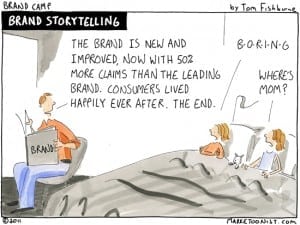There is plenty of advice out there on how to create a great presentation. Most of it centers on two pretty common pieces of advice:
- Tell more stories.
- Use bigger fonts.
Neither is always easy to do, but the more events I attend – the more I realize a single fact that still manages to surprise me about why people do (or don’t) connect with you as a speaker.
Having a good story is not enough.

After having listened and taken notes on hundreds of presentations (including my own!), it turns out there are some very specific landmines that can sabotage anything you say – no matter how well crafted your presentation may be. With most, the end result is that you lose the attention or trust of an audience member immediately – and it becomes nearly impossible to get it back.
Presentation suicide can happen in a moment.
There are a small number of common mistakes that I have seen speakers most often make to lose their audience. Yes, some of these I have learned the hard way … but hopefully sharing them here will help you avoid making them unintentionally the next time you need to make a presentation or a pitch.
Mistake #1: Preamble Overdose
Tip: Don’t give an introduction that lasts forever.
Just about every listeners least favourite words to hear at the start of a presentation are “let me tell you a little bit about myself.” Most of the time we have your bio already. Even if we don’t, the last thing we need is a five minute recitation of your bio. Wasting your audience’s time with that puts you in a credibility hole that is tough to dig yourself out of – so just skip the self serving bio … or at least move it to the end of your presentation.
Mistake #2: Toxic Words
Tip: Avoid loaded buzzwords or stereotypes that show ignorance.
Every industry and audience has hot button words or issues. Entrepreneurs who work from home hate the implication that they have “plenty of free time.” PR pros hate the assumption that all they do is write press releases. Most psychologists hate to be called “shrinks,” accountants don’t like to be “bean counters” and the list goes on and on. If you happen to be presenting to a group that has it’s own lingo (and most do) – always try to learn what words fit this category and what terms to avoid.
Mistake #3: Personal Disconnection
Tip: Be careful sharing beliefs that can evoke passionate disagreement.
It is a widely recognized that there is rarely an upside to including anything about religion or politics in a business setting (unless of course your audience is comprised of people from one setting or the other). What we sometimes forget is that there are other hot topics that can be just as polarizing. Puma and Adidas, for example are huge rivals. Mentioning one to the other will evoke a passionate response. The same goes for local or national sports teams. If the topic of your talk has nothing to do with these outside influences, you are always better off to keep them to yourself.
Mistake #4: Experience Blindness
Tip: Find a way to empathize with those whose experience varies from yours.
One of the easiest things to do is to look at the world of business and culture from your own lens. This may mean from a geographic point of view, but also include industry biases. The rules of what is permissible vary from industry to industry and across geographies as well. You don’t need to be an expert in how religion effects banking in Muslim countries, for example … but recognizing that your experience doesn’t always work everywhere in the world can go a long way to establishing credibility with a group that has a background unlike your own.
Mistake #5: Demographic Mismatch
Tip: Gather information on the best tone, clothing and level of formality expected.
Two of my least favourite words in the world are “business casual.” Why? Because this can mean many different things to many different groups. One time I spoke in front of a large group of managers from the travel industry on digital trends. I wore black jeans and a sports coat (my impression of business casual). Afterwards I got an angry email from an audience member who couldn’t believe I wasn’t wearing a suit with a tie. I’ve never been fond of dress codes – but now I always ask event organizers what “business casual” actually means.
In modern business, chances are you will have plenty of opportunities to present yourself or your ideas in front of an audience. That chance may come in a job interview, or on stage in front of several hundred of your peers. No matter when that chance happens, your success may depend on your ability to make the most of it. Telling stories or practicing the basics like making eye contact and cutting the “ums and ahs” from your speaking will certainly help … but if you really want to stand out, avoiding these five common mistakes will help. Along with reducing those bullet points, of course.







WE RECENTLY REMOVED COMMENTING - LEARN WHY HERE >